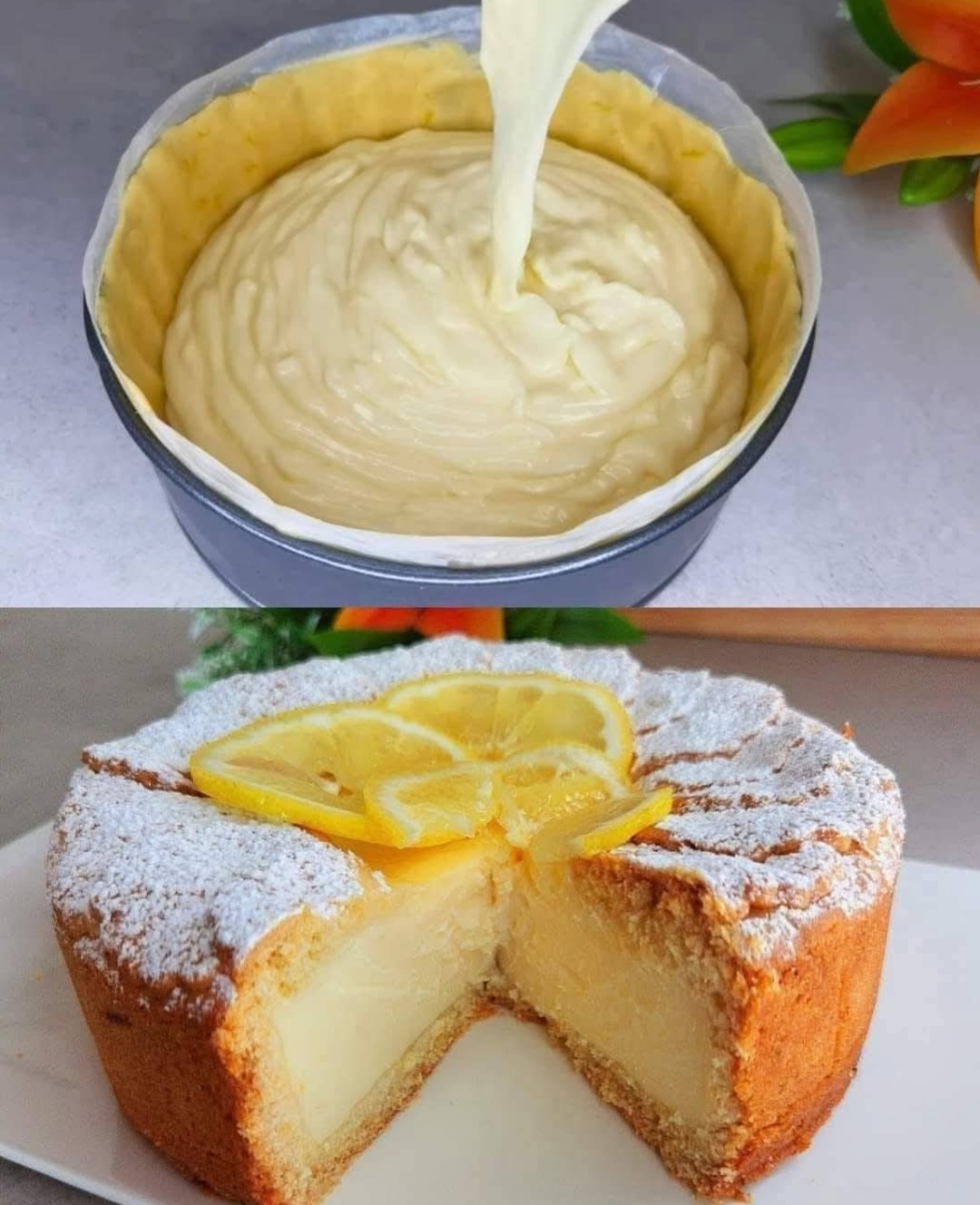Ingredients:
For the Crust (Optional):
1 1/2 cups (180g) all-purpose flour
1/2 cup (115g) butter, softened
1/4 cup (50g) sugar
Pinch of salt
1 egg yolk
For the Custard Filling:
4 large eggs (room temperature, separated)
3/4 cup (150g) sugar
1/2 cup (115g) melted butter (cooled)
1/2 cup (60g) all-purpose flour
1/4 cup (60ml) lemon juice (freshly squeezed)
2 tsp lemon zest
2 cups (500ml) warm milk
1/2 tsp vanilla extract
A pinch of salt
Topping (Optional):
Powdered sugar
Lemon slices for decoration
Instructions:
1. Prepare the Crust (Optional):
Mix flour, sugar, butter, salt, and egg yolk until a soft dough forms.
Press into a greased and lined springform pan to cover the base and about halfway up the sides.
Chill while preparing the filling.
2. Make the Lemon Custard Batter:
Preheat oven to 325°F (160°C).
Separate the eggs. Beat the egg yolks with sugar until pale and creamy.
Mix in melted butter, lemon zest, lemon juice, and vanilla.
Add flour and mix until smooth.
Slowly add warm milk and whisk until well combined. The batter will be very liquid.
In a clean bowl, beat the egg whites with a pinch of salt until stiff peaks form.
Gently fold the egg whites into the batter in three parts (don’t overmix, some clumps are okay).
3. Bake:
Pour the batter over the crust (or directly into the lined pan if no crust).
Bake for 50–60 minutes until the top is golden and set. The center should still have a slight jiggle.
Let it cool completely, then refrigerate for a few hours or overnight.
4. Serve:
Dust with powdered sugar.
Garnish with lemon slices.
Slice and enjoy the custard-like layers.
Variations
For a tangier twist, try adding a tablespoon of lime juice along with the lemon juice to enhance the citrus flavor. If you prefer a richer custard, substitute half of the milk with heavy cream for a creamier texture. For a gluten-free version, replace the all-purpose flour with almond flour or a gluten-free flour blend, ensuring the crust and filling maintain their structure.
If you enjoy a fruity touch, swirl in some raspberry or blueberry puree into the batter before baking for a berry-lemon fusion. Chocolate lovers can add a layer of chocolate ganache between the crust and custard or sprinkle chocolate chips on top before baking. For a tropical vibe, replace the lemon zest with orange or lime zest and top with toasted coconut flakes.
For a lighter dessert, skip the crust and bake the custard in individual ramekins for a elegant presentation. You can also experiment with herbs like thyme or basil infused into the warm milk for a subtle aromatic twist. If you’re feeling adventurous, a dash of cardamom or cinnamon in the custard adds warm, spicy notes that pair beautifully with the lemon.
Tips
Ensure all ingredients, especially the eggs and milk, are at room temperature to achieve a smooth, lump-free custard. When folding in the egg whites, use a gentle hand to maintain the airiness, which gives the dessert its light texture.
If the top browns too quickly during baking, cover it loosely with aluminum foil to prevent burning while the center sets.
For the best crust, press the dough evenly and firmly into the pan to avoid cracks or uneven baking.
If the custard cracks while cooling, don’t worry—it’s normal and will still taste delicious. To enhance the lemon flavor, let the zest steep in the warm milk for 10 minutes before mixing it into the batter.
To test for doneness, the edges should be set, and the center should jiggle slightly when shaken. The custard will continue to firm up as it cools.
For clean slices, use a sharp knife dipped in hot water and wiped dry between cuts. If serving chilled, let the dessert sit at room temperature for 10–15 minutes to soften slightly for the best texture.
How to Store
Store the cooled dessert in an airtight container or covered with plastic wrap in the refrigerator for up to 3 days. The custard’s texture may firm up over time, but it will still retain its flavor.
If you’ve added powdered sugar or toppings, apply them just before serving to prevent sogginess.
For longer storage, you can freeze the dessert (without toppings) for up to 1 month. Thaw it overnight in the refrigerator before serving.
Note that the texture may change slightly after freezing, becoming denser. If storing individual slices, separate them with parchment paper to avoid sticking.
To maintain freshness, avoid leaving the dessert at room temperature for more than 2 hours. If preparing ahead, bake the crust and custard separately, then assemble before serving to keep the crust crisp.
For meal prep, portion the dessert into single servings for easy grab-and-go treats throughout the week.
Conclusion
This lemon custard dessert is a delightful balance of tangy and sweet, with a creamy texture that melts in your mouth. Whether you opt for the buttery crust or a crustless version, it’s a versatile treat that can be customized to suit your taste. The light, airy layers make it perfect for any occasion, from casual gatherings to elegant dinners.
With simple ingredients and easy techniques, this recipe is accessible to bakers of all levels. The make-ahead option ensures stress-free entertaining, and the variations allow for endless creativity. Serve it chilled with a dusting of powdered sugar, and enjoy the refreshing burst of lemon in every bite!
